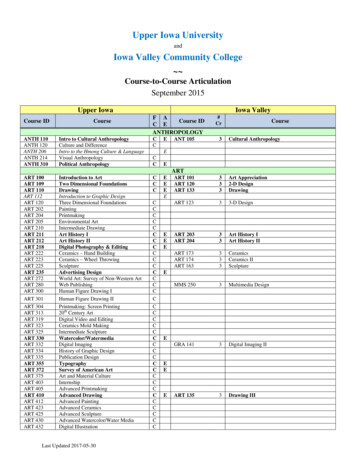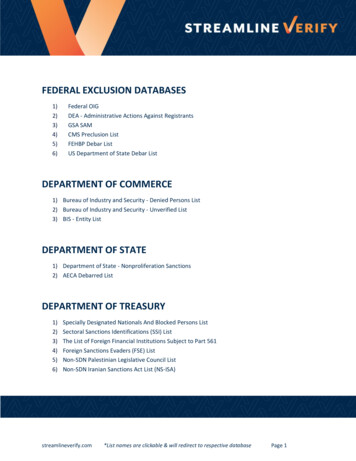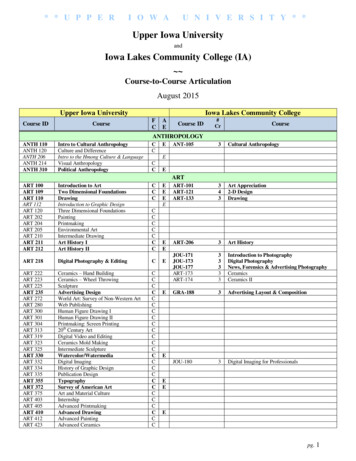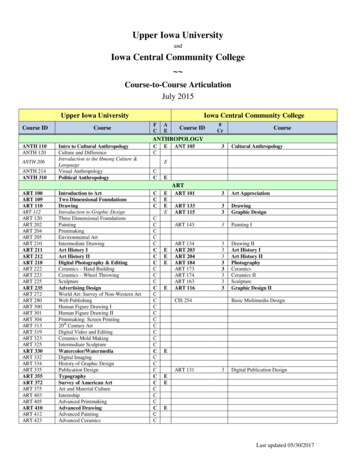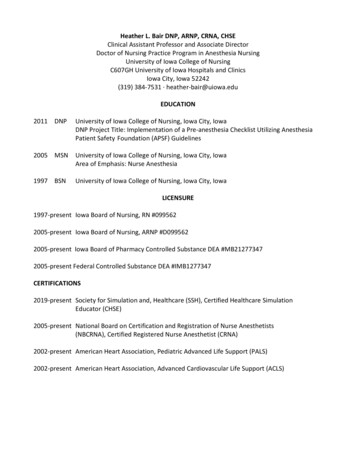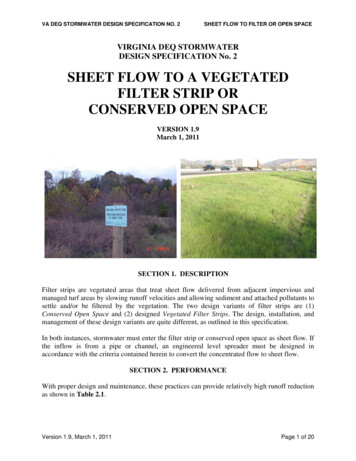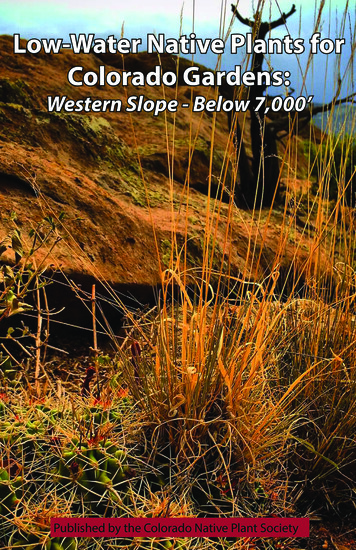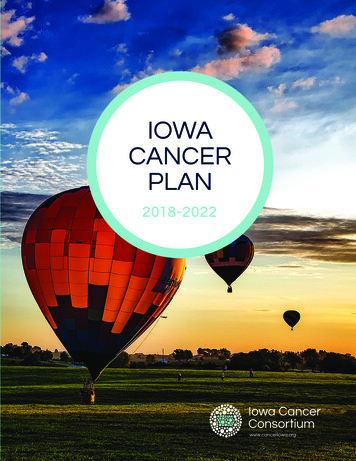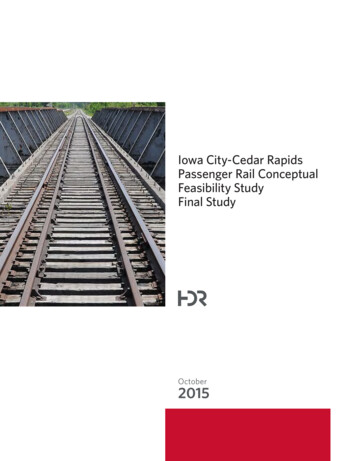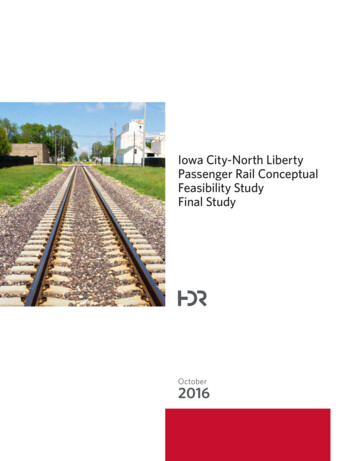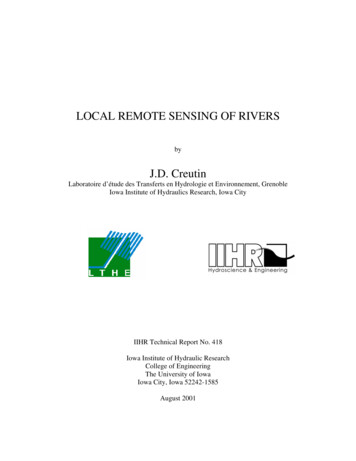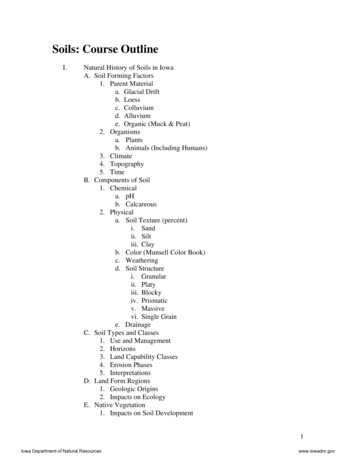
Transcription
Soils: Course OutlineI.Natural History of Soils in IowaA. Soil Forming Factors1. Parent Materiala. Glacial Driftb. Loessc. Colluviumd. Alluviume. Organic (Muck & Peat)2. Organismsa. Plantsb. Animals (Including Humans)3. Climate4. Topography5. TimeB. Components of Soil1. Chemicala. pHb. Calcareous2. Physicala. Soil Texture (percent)i. Sandii. Siltiii. Clayb. Color (Munsell Color Book)c. Weatheringd. Soil Structurei. Granularii. Platyiii. Blockyiv. Prismaticv. Massivevi. Single Graine. DrainageC. Soil Types and Classes1. Use and Management2. Horizons3. Land Capability Classes4. Erosion Phases5. InterpretationsD. Land Form Regions1. Geologic Origins2. Impacts on EcologyE. Native Vegetation1. Impacts on Soil Development1Iowa Department of Natural Resourceswww.iowadnr.gov
a. Forestsb. Prairiesc. WetlandsII.Soil EcologyA. Defining Soil EcologyB. Biotic FactorsC. Nutrient CyclesD. Abiotic FactorsIII.Soil ManagementA. Land Use In Iowa1. Private Ownership2. Public Ownership3. Agriculturala. Row Croppedb. Hayc. Pastured. Private Forestse. Water Covered4. Non-Agriculturala. Incorporated Areasb. Recreational Areasc. RoadsB. Conservation/Tillage Practices1. Erosiona. RUSLE2 (Soil Loss Equation)2. Siltation (Deposition)3. Drainage Systemsa. Surfaceb. Subsurface4. Residue Managementa. No-Tillb. Terracesc. Drainagewaysd. Filter Stripse. Buffer Strips5. Soil PropertiesC. Equipment1. Soil Survey Books2. EFOTG (Electronic Field Office Technical Guide)3. Munsell Color Book4. Clinometer5. Soil Quality Test Kit6. Soil Probesa. Hand2Iowa Department of Natural Resourceswww.iowadnr.gov
b. HydraulicD. EconomicsE. Agencies1. USDA-NRCS2. DNR3. SWCD4. FSA5. CDI6. IDALS-DSC7. Extension ServiceF. Programs1. Local2. State3. FederalIV.CareersA. Governmental1. Local2. State3. FederalB. PrivateV.AppendixA. TermsB. ResourcesC. Curriculum Standards1. Agriculture2. Science3Iowa Department of Natural Resourceswww.iowadnr.gov
Soil: TermsA-horizonalluviumB-horizonbottomlandbuffer stripC-horizoncalcareous soilsclasses of erosionclaycolluviumconservation tillagecontouringcorn suitability rating - CSRdrainageE-horizonerosionexternal soil featuresfertilityfilter stripfootslopeforest vegetationglacial driftgrass waterwaygulley erosionhumusinfiltrationintermittent drainagewaysinternal soil featureslandformlandscape positionlandscape topographyleachinglimited (rating)loessloammacro nutrientsmarsh vegetationmicro nutrientsmoderate (erosion rating)mottlingmucknative vegetationno-tillnot limited (rating)nutrient cyclesO-horizonorganic matterparent materialspeatpercolatespermeabilityprairie vegetationR-horizonresiduumrill erosionRUSLE2sandy claysandy clay loamsandy loamseepagesevere (erosion rating)sheet erosionshrink-swellsiltsilty claysilty clay loamsilty loamslight slopesoil componentssoil conditionssoil conservation practicessoil profilesoil ratingssoil texturestrip croppingsurface drainagesubsurface drainageterraceterracingtilthtransition vegetationuplandvery limited (rating)weatheringwetness4Iowa Department of Natural Resourceswww.iowadnr.gov
Soil: ResourcesThe following resources were suggested by the writers and reviewers. There are manyadditional resources available and many more being developed daily, especially via theweb. Website resources contain lists of publications related to specific topics. Individualbooks or pamphlets were not listed because of space. Please view these as a startingpoint and add others to the list as you develop your specific course objectives.Websites:Conservation Districts of IowaConservation Districts of Iowa (CDI) is a nonprofit organization devoted toproviding educational programs on the conservation of soil, water, and othernatural resources. CDI coordinates Iowa’s Envirothon program.http://www.cdiowa.orgIowa Department of Agriculture and Land StewardshipInformation and publications related to Iowa’s Agriculture andConservation/Natural Resource issues and .htmIowa Department of Natural ResourcesInformational materials on Geology, Geologic Resources, Topographic Mapshttp://www.igsb.uiowa.edu/Iowa State University Extension PublicationsExtensive publication list related to soils, soil judging, and ited States Department of Agriculture (USDA): Natural Resources ConservationService (NRCS)Informational materials on soils, soil management, soil science, soil surveyshttp://www.soils.usda.gov5Iowa Department of Natural Resourceswww.iowadnr.gov
Books & Pamphlets:Iowa’s Natural Heritage. Iowa Academy of Science and Iowa Natural HeritageFoundation. 1982. Call Iowa Natural Heritage at 1-515-288-1846.Landforms of Iowa. Jean C. Prior, IDNR, order at http://www.iowadnr.gov/pub.htmlManaging Our Natural Resources. Camp, William G., etal. 2002. DELMAR, 4th ed.http://www.Agriscience.Delmar.comProfessional Soil Classifiers of Iowa Soil Texture Soil Survey Books. Contact your local USDA Service Center Office, orhttp://www.soils.usda.gov/survey6Iowa Department of Natural Resourceswww.iowadnr.gov
Soils: Curriculum Standards and BenchmarksAgricultural EducationStandards, Benchmarks, and Performance IndicatorsAgricultural Business, Supply & ServiceStandard AB-1: Understand problem-solving, analysis, and decision-making inagriculture.BenchmarksA. Analyze situation, use problem-solving approach and make appropriate decisions.3. Interpret the results from a soil and/or tissue test.4. Determine appropriate land use management based on soil evaluation needs.Standard AB-12: Understand basic technical skills and knowledge in the occupationalarea of agricultural business, supply and service.BenchmarkL. Apply technical skills in a hands-on experiential setting in agriculture.32. Identify the types of tillage methods used in crop production.34. Explain the role of primary and secondary nutrients used in crop production.39. Read a soil classification map.Agricultural ProductionStandard AP-10: Understand basic computational and informational technology.BenchmarkJ. Apply computational and informational technologies to analyze and solvemathematical problems.1. Evaluate and demonstrate use of current technology in land surveying and measuring.2. Utilize digitized soil surveys to establish a soil sampling method and formulate a nutrient.Standard AP-12: Understand basic technical skills and knowledge in the occupationalarea of production agriculture.BenchmarkK. Apply technical skills in a hands-on experiential setting in agriculture.4. Analyze the environmental effect that agricultural stewardship may have on surface andground water, wildlife, soil, air, and people.19. Explain soil and water conservation practices and their part in federal program compliance.20. Explain the factors involved with seed and plant selection.7Iowa Department of Natural Resourceswww.iowadnr.gov
21. Identify and demonstrate plant growth and reproduction.22. Identify and select biological and chemical pest controls for agronomic production.34. Use the survey plat of township, range and section to describe an area.HorticultureStandard H-1: Understand problem solving, analysis, and decision-making in agriculture.BenchmarksA. Analyze situation, use problem-solving approach and make appropriate decisions.3. Interpret data of soil sample analysis.5. Choose an appropriate plant for a specific location in a home or business.Standard H-12: Understand basic technical skills and knowledge in the occupational areaof Horticulture.BenchmarkL. Apply technical skills in a hands-on experiential setting in agriculture.2. Take soil samples52. Explain factors affecting plant growth: light, water, temperature, humidity, nutrients(micro/macro), soils, atmosphere, and pollutants.Natural ResourcesStandard NR-1: Understand problem solving, analysis, and decision-making inagriculture.BenchmarkA. Analyze situation, use problem-solving approach and make appropriate decisions.1. Assess and implement BMPs (Best Management Practices) related to agriculturedrainage wells, erosion control, irrigation of wastewater, irrigation of groundwater, useof storage tanks (i.e., fuels, Anhydrous Ammonia, etc.) and wellhead and source of waterprotection which improve water quality.8. Determine soil amendments necessary based on soil tests, realistic yield goals, and thefertility level of a given piece of land.9. Identify and evaluate conservation tillage systems and their productivity, profitability andenvironmental impact.12. Evaluate various solid waste disposal systems by their environmental impact.Standard NR-4: Understand the use of entrepreneurial knowledge and skills inagriculture.BenchmarkD. Use appropriate communication skills in a variety of occupational situations inagriculture.8Iowa Department of Natural Resourceswww.iowadnr.gov
3. Recognize the importance of technical assistance.Standard NR-7: Understand the principles of planning.BenchmarkG. Apply planning strategies in natural resources management.6. Develop plans which incorporate the use of federal, state, and local agriculture programsto sustain resources (i.e., buffer strips).Standard NR-8: Understand the concept of adapting to change in agriculture.BenchmarkH. Develop strategies to effectively adapt to new situations and rapid changes inagriculture.1. Identify contemporary natural resources issues/concerns relating to agriculture.2. Adapt to environment/situation.Standard NR-9: Understand global and cultural diversity issues.BenchmarkI. Demonstrate a working knowledge of the relationship between global/cultural diversityand occupational success in agriculture.1. Describe global environmental impact.2. Explain global positioning systems and graphic information systems andunderstand practice application.Standard NR-10: Understand basic computational and informational technology.BenchmarkJ. Apply computational and informational technologies to analyze and solvemathematical problems.2. Measure and calculate land area, length, and percent slope.Standard NR-11: Understand the concept of career development and improvement –lifelong learning.BenchmarkK. Develop strategies to make a successful transition from school to work.1. Identify a minimum of five (5) environmental and natural resource occupations andexplain the job requirements, major activities performed by persons in these occupationsand availability by location.2. Explain the connection between the natural resources occupations, agribusiness, andtechnology.9Iowa Department of Natural Resourceswww.iowadnr.gov
Standard NR-12: Understand basic technical skills and knowledge in the occupationalarea of natural resources.BenchmarkL. Apply technical skills in a hands-on experiential setting in agriculture.1. Explain the economic impact of the loss of wildlife, habitat, urban sprawl, and navigationon wildlife resources.5. Describe the connections between land use, rural Iowa, and agriculture.6. Locate a plot of land given a legal description.7. Explain basic soil morphology and its relationship to management.8. Explain the impact agriculture, industry, and population centers have on natural resourcesand the environment.9. Use soil survey, topography maps, aerial photos, and other natural resources inventories tointerpret, compare (limits and potentials), and plan wise land management.10. Identify federal, state, and local regulations related to soil and water conservation, waterquality, forestry, air quality, and wildlife. Explain their applicability to resourcemanagement.12. Determine crops and crop management that will provide habitat for wildlife.20. Describe how Iowa climate and weather is relevant to natural resources and agriculturalresource management.23. Select appropriate conservation practices that will reduce erosion and improve waterquality on a farm and urban area.24. Describe the types of wind and water erosion and determine soil erosion rates andresulting economic and environmental losses to society.25. Explain the principles of integrated crop (fertility levels, pests) management.26. Explain the techniques of crop cultivation and how they interrelate with the environment.28. Explain the importance of protecting ground and surface water resources.30. Explain current issues involved in natural resource management.32. Describe current animal waste regulations as they apply to the environment.33. Explain State and Federal Ag and Natural Resource Management Agencies and theirfunctions.34. Explain the hydrologic cycle.35. Identify local sources of ground and surface water contamination and explain techniquesfor protecting these resources.36. Identify and incorporate nutrient management practices including spreading lagoonfertilizers, commercial applicator training, composing of manure and animal carcasses,managing wastes from food processing facilities through composting, developing manuremanagement plans, the application of municipal sludge, and the storage, handling, andtransfer of chemicals into agricultural plans.40. Incorporate wildlife depredation prevention into animal husbandry practices.Agricultural MechanicsStandard AM-12: Understand basic technical skills and knowledge in the occupationalarea of agricultural mechanics.BenchmarkL. Apply technical skills in a hands-on experiential setting in agriculture.10Iowa Department of Natural Resourceswww.iowadnr.gov
26 Identify types of erosion control structures.Source: Iowa Content Standards and Benchmarks for Agricultural Education, IowaDepartment of Education, 1999.11Iowa Department of Natural Resourceswww.iowadnr.gov
Science StandardsStandard 2: Understands Earth’s composition and structureLevel III3. Knows components of soil and other factors that influence soil texture, fertility, andresistance to erosion (e.g., plant roots and debris, bacteria, fungi, worms, rodents)Level IV3. Knows that elements exist in fixed amounts and move through the solid Earth, oceans,atmosphere, and living things as part of geochemical cycles (e.g., carbon cycle, nitrogencycle)4. Knows that throughout the rock cycle (e.g., formation, weathering, sedimentation,reformation), the total amount of material stays the same as its form changes6. Knows the conditions of Earth that enable it to support life (e.g., force of gravity thatenables the planet to retain an adequate atmosphere, intensity of radiation from the Sunthat allows water to cycle between liquid and vapor)Source: Compendium of K-12 Standards, McREL, .asp?SubjectID 212Iowa Department of Natural Resourceswww.iowadnr.gov
Iowa Department of Natural Resources www.iowadnr.gov. 10 Standard NR-12: Understand basic technical skills and knowledge in the occupational area of natural resources. Benchmark L. Apply technical skills in a hands-on experiential setting in agriculture. 1. Explain the economic impact of the loss of wildlife, habitat, urban sprawl, and navigation
